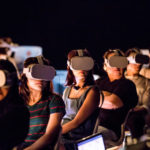Lessons of the Blood
2010 - Film & Video (Film & Video)
1:46:30 minutes
James T. Hong
Lessons of the Blood by James T. Hong pieces together interviews, extensive archival and field research, and TV footage addressing Japan’s use of biological warfare and experimentation on Chinese prisoners during World War II, as well as the revisionism of the Japanese government and Chinese survivors’ attempts to live with this horrific history and to find justice. Co-written, directed, edited and produced with Yin-Ju Chen, whose work is also represented in the Kadist collection, Lessons of the Blood is a meditation on propaganda, the ways in which national mythologies can literally infect and poison the most vulnerable among us, and the legacy of World War II in China, presented through the testimonies of survivors, academics, medical experts, nationalists and activists. The film locates its genesis in the publication of the New History Textbook in Japan in 2000, which infamously glossed over the Japanese Empire’s wartime atrocities, sparking rage and violent protests in China and South Korea in 2005. Using the publication of the textbook as a point of departure, Hong and Chen spent six years — starting in 2004 — following disparate strands of research, including tracking down and interviewing over twenty survivors in China — many of whom lived in highly inaccessible, rural enclaves, spoke local dialects rather than Mandarin, and were locatable only by visiting these villages in person and forming relationships within the local community. Lessons of the Blood also acts as a legal document, as Hong and Chen’s research and documentation were used to aid the survivors after an initial unsuccessful lawsuit against the Japanese government. Because the film spans a period of six years, it subsequently chronicles — through the eyes of ordinary people left behind by both Chinese and Japanese nationalistic agendas — the changes in a rapidly changing China, which chose to remain silent about its Pacific neighbor’s wartime atrocities for many decades because of its economic dependency on Japan.
James T. Hong is an Asian-American filmmaker and artist whose works focus on controversial race and class issues, and historical conflicts in Asia. His film, 731: Two Versions of Hell (2007), was awarded the Best World Documentary Award at the Jihlava International Festival in 2007. Other film productions include Lessons of the Blood (2010) and The Turner Film Diaries (2012).
Colors:
Related works of genres: » american experimental filmmakers
» see more

© » KADIST
Nathaniel Dorsky
2010Dorsky’s pieces included in the Kadist Collection are small still photographs from twelve of his most important films...

© » KADIST
George Kuchar
2009Burrito Bay is a video by George Kuchar that follows the format of a diary or travelogue centered on a tropical trip to Acapulco, Mexico...

© » KADIST
Bruce Conner
2008Unlike many of his earlier films which often present poignant critiques of mass media and its deleterious effects on American culture, EASTER MORNING , Conner’s final video work before his death in 2008, constitutes a far more meditative filmic essay in which a limited amount of images turn into compelling, almost hypnotic visual experience...

© » KADIST
Bruce Conner
1978In 1977, as an already-established artist best known for his films, Bruce Conner began to photograph punk rock shows at Mabuhay Gardens, a San Francisco club and music venue...
Other related works, blended automatically
» see more

© » KADIST
James T. Hong
2012Taiwan WMD (Taiwan and Weapons of Mass Destruction) is part of a long-term research started in early 2010 on the history and aftermath effects of Japanese biological and chemical warfare in China during WWII, as well as the unknown history of Taiwan’s nuclear program...
Related works sharing similar palette
» see more

© » KADIST
arquivo mangue
2022o que diriam as pedras a marte? [What would the stones say to Mars?] is a sculptural work consisting of two parts by arquivo mangue...

© » KADIST
Alicia McCarthy
2010A painting reminiscent of a certain “naive primitivism,” Untitled (Colors) and Untitled (Ghost) are representative of McCarthy’s work...

© » ARTS EQUATOR
Reconstructing the Virtual in “Frogman” | ArtsEquator Thinking and Talking about Arts and Culture in Southeast Asia Articles Courtesy of Arts House Limited June 14, 2019 By Shawn Chua (1,088 words, 6-minute read) Having securely fastened the headgear, I am submerged into the virtual world of Frogman...
Other works by: » James T. Hong
» see more

© » KADIST
James T. Hong
2012Taiwan WMD (Taiwan and Weapons of Mass Destruction) is part of a long-term research started in early 2010 on the history and aftermath effects of Japanese biological and chemical warfare in China during WWII, as well as the unknown history of Taiwan’s nuclear program...
Related artist(s) to: James T. Hong » Pak Sheung Chuen, » Cosmin Costinas, » Irene Kopelman, » Moe Satt, » Adrian Wong, » Bernd Behr, » Dung Kai-Cheung, » Fionnuala McHugh, » Firenze Lai, » George Chinnery
» see more

© » KADIST
Adrian Wong
2012Untitled (Grate I/II: Shan Mei Playground/ Grand Fortune Mansion) is part of a series drawn from architectural objects that mark the boundary of public and private spaces Wong encountered while strolling in Hong Kong...

© » KADIST
Pak Sheung Chuen
2017The series Nightmare Wallpapers represents a shift if Chuen’s practice, allowing the artist to immerse himself in an “artistic pilgrimage of self healing” following the failure of the 2014 Umbrella Movement...

© » KADIST
Firenze Lai
2013Central Station, Alignment, and Sumo are “situation portraits” that present whimsical characters within distorted and troubling worlds...
Related works found in the same semantic group
» see more

© » KADIST
Jane Jin Kaisen and Guston Sondin-Kung
2010The Woman, The Orphan, and The Tiger begins with the sound of women’s voices describing histories of violence, of things repressed and silenced...

© » KADIST
Shimpei Takeda
2012While still living in New York, shortly after the nuclear power plant disaster, Shimpei Takeda heard an NPR interview with a survivor living in temporary housing in Fukushima...




